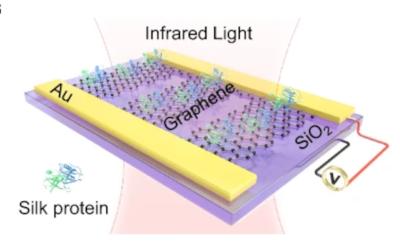Researchers at the University of Hong Kong, National Center for Nanoscience and Technology in Beijing, Harvard University and the University of Stuttgart have advanced the field of molecular sensing by developing a novel method to improve the sensitivity of surface-enhanced infrared absorption (SEIRA). SEIRA uses plasmonic nanostructures to amplify the infrared signals of molecules adsorbed on their surface. Graphene is a particularly promising material for SEIRA because of its high sensitivity and tunability. However, the interaction between graphene and molecules is weakened by intrinsic molecular damping.
The new approach employs synthesized complex-frequency waves (CFW) to amplify the molecular signals detected by graphene-based sensors by at least an order of magnitude. It also applies to molecular sensing in different phases.
SEIRA was first demonstrated using Ag and Au thin films but the advancement of nanofabrication and the development of new plasmonic materials have led to plasmonic nanostructures capable of much greater enhancement of biomolecule signals. Compared to metal-based SEIRA, strong field confinement supported by two-dimensional (2D) Dirac fermion electronic states enables graphene-based SEIRA with excellent performance in molecular characterization for gas and solid phase sensing. Graphene can also enhance molecular IR absorption in aqueous solution.
The active tunability of graphene plasmons broadens their detection frequency range for different molecular vibrational modes by changing the doping level via gate voltage. These advantages make graphene-based SEIRA a unique platform for molecular monolayer detection. However, intrinsic molecular damping significantly reduces the interaction between the vibrational modes and plasmons. As a result, at very low concentrations, the spectra of plasmon-enhanced molecular signals become very weak and broad, ultimately overshadowed by noise.
One way to compensate for molecular damping is to add optical gain materials. However, this requires a complex setup which may not be compatible with the detection system. In addition, gain materials usually increase instability and noise.
Another possibility is to use complex-frequency waves (CFW); theoretical studies have proved that CFW with temporal attenuation can restore information loss due to material losses. However, producing CFW in real optical systems remains a challenging task.
The researchers proposed a new method for synthesizing CFW by combining multiple real-frequency waves. This method has been successfully applied to improve the spatial resolution of superlenses. The researchers demonstrated that synthesized CFWs can dramatically enhance the molecular vibrational fingerprints in graphene-based SEIRA. They successfully apply synthesized CFWs to improve the molecular signals in the mid-IR extinction spectrum for biomolecules under different conditions, including direct measurement of multiple vibrational modes of deoxynivalenol (DON) molecules and graphene-based SEIRA of proteins in both solid phase and aqueous solution.
This new approach to SEIRA using synthesized CFWs is highly scalable to various SEIRA technologies and can generally increase the detection sensitivity of traditional SEIRA technologies. It could be used to develop ultrasensitive sensors for a wide range of applications, such as early disease diagnosis, personalized medicine, and rapid detection of toxic agents. This approach has great potential in the field of molecular sensing, enabling the detection of trace molecules that are currently undetectable.
